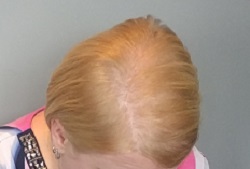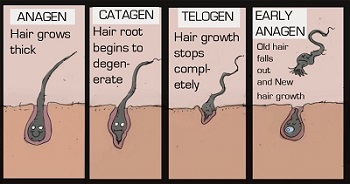What is Telogen Effluvium?

Telogen effluvium (TE) is a condition that involves temporary loss of large quantities of hair. It is due to shedding of telogen (resting phase) hair. This loss of hair typically arises as a result of some major shock to a person’s biological system.
An effective treatment for telogen effluvium will first and foremost need to tackle the initial cause of the shedding. Medications and natural hair loss treatments for telogen effluvium will not work unless the underlying cause is not addressed first.
Among events that can cause telogen effluvium include:
- Surgery.
- Illness, especially when including fever.
- Sudden extreme weight loss.
- Stress and panic attacks.
- Psychological disturbances.
- Drastic changes in dietary and eating habits, including crash diets.
- Traumatic life events.
- Hair cycle disorders.
- Lupus.
- Hormonal fluctuations such as those accompanying menopause.
- Thyroid disorders (both hyperthyroidism and hypothyroidism).
- Vitamin deficiencies (e.g., vitamin D and vitamin B12).
- Side effects from taking new medications or stopping old ones.
Note that the average person naturally loses around 100 scalp hairs every day. In TE, the rate of hair loss is at least several times larger than what would be normally expected. The hair pull test will usually be positive in patient’s suffering from TE. Diagnosis methods can also include the use of a trichogram, trichoscopy and biopsy.
Symptoms
The first signs of telogen effluvium are often when you notice shedding of a lot more hair than usual. Your pillowcases, bedsheets, shower drain, floors and hairbrushes will all have more hair on them that normal. Note that the period of dramatic hair loss associated with TE typically occurs approximately 2-3 months after the triggering event. The pattern of hair loss associated with TE is diffuse and nonscarring. Typically, once you lose 50 percent of your hair, telogen effluvium will not progress any further.
Recovery
The vast majority of people completely recover from telogen effluvium hair loss. However, it typically takes around six months to see full recovery and regrowth. Moreover, one has to identify the root cause of the initial shedding and make sure that this is addressed immediately.
Phases of the Hair Growth Cycle

In most humans, around 85 percent of scalp hair is actively growing, and therefore said to be in anagen phase. A typical scalp hair is in anagen phase for 2-7 years, with the exact duration dependent upon many factors, including: age, sex, ethnicity and overall genetics. In contrast to scalp hair, eyebrow hair has a much shorter anagen phase of just around one month.
Once hair has completed its growth phase, it enters a brief transitional stage called catagen. This phase lasts for around 2-3 weeks, during which the hair converts into a club hair. This conversion process occurs when the blood supply to the hair follicle is cut off.
Finally, once the hair become bulbous with a club-shaped tip, it enters what is known as the telogen or resting phase. During the telogen phase, the dermal papilla no longer supplies any nutrients to the the hair follicle. The telogen phase lasts for around 3 months. Thereafter, hair re-enters into anagen phase and the whole cycle repeats.
Telogen Effluvium versus Anagen Effluvium
Note that the hair loss condition that is known as anagen effluvium is not the same as telogen effluvium. Anagen effluvium is a condition in which hair starts shedding during the anagen (growth) stage of the hair cycle due to interruption of the hair growth process. In contrast, telogen effluvium arises during the telogen (resting) stage of the hair cycle.
Anagen effluvium also leads to far greater and rapid hair loss in comparison to telogen effluvium. The main reason for this is due to the fact that there are far more hairs in anagen phase than telogen phase as outlined earlier. Anagen hairs have a pointed or tapered tip and feathered roots.
Note that telogen effluvium falls under ICD-10 L65.0 under the 2016 International Statistical Classification of Diseases and Related Health Problems.
Is telogen effluvium more common in women or in men?
I mostly see women now since it’s a side effect of Covid.